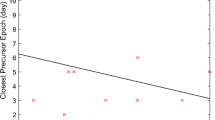Abstract
Recently, researchers have conducted long-term statistical studies to prove the correspondence between earthquakes and thermal infrared (TIR) anomalies. Upon obtaining relatively high true positive rates (TPR), it was concluded that TIR anomalies are closely related to earthquakes. However, the temporal-spatial clustering of earthquakes and overly large temporal-spatial windows will also contribute to high TPRs, and it is improper to correlate TIR anomalies with earthquakes without excluding these influences. In this paper, relevant studies will be tested according to the prior probability, random earthquake catalogs and Molchan diagram weighted by the Relative Intensity (RI) index. Our results show that the high TPR in the previous studies were caused by overly large determining windows, and the result was close to random guessing, which means that the extracted TIR anomalies make no contributions to predicting the timing, epicenter and magnitude of earthquakes. By comparing the original Molchan diagram and the Molchan diagram weighted by the RI index, we found that simply taking the fraction of space-time occupied by alarm may give a wrong evaluation for alarm. Moreover, long-term statistical evidence proving the correspondence between earthquakes and TIR anomalies in Greece and Taiwan are still absent.
Similar content being viewed by others
References
N. Genzano, et al., Nat. Hazards Earth Syst. Sci. 9, 2073 (2009).
V.I. Gorny, A.G. Salman, A.A. Tronin, Proc. USSR Acad. Sci. 301, 67 (1988).
D. Ouzounov, F. Freund, Adv. Space Res. 33, 268 (2004).
Z.J. Qiang, C.G. Dian, Geoscience 6, 297 (1992).
A.A. Tronin, Int. J. Remote Sens. 17, 1439 (1996).
A.A. Tronin, M. Hayakawa, O.A. Molchanov, J. Geodyn. 33, 519 (2002).
M. Bellaoui, A. Hassini, B. Kada, Adv. Space Res. 59, 2645 (2017).
F. Boudin, et al., Evidence for slow slip events preceeding the M8, April 1rst, 2014 Pisagua earthquake (Chile), from an underground, long base hydrostatic tiltmeter, in AGU Fall Meeting (American Geophysical Union, Washington, DC, 2014).
N.A. Bryant, R.B. Nathan, Observed weather satellite thermal responses prior to and after earthquakes, in AGU Fall Meeting 2003 (American Geophysical Union, Washington, DC, 2003).
S. Choudhury, A.K. Saraf, Int. J. Remote Sens. 26, 2705 (2005).
C. Filizzola, et al., Phys. Chem. Earth Parts A/B/C 29, 517 (2004).
N. Genzano, et al., Tectonophysics 431, 197 (2007).
N. Genzano, et al., J. Asian Earth Sci. 114, 289 (2015).
F. Jing, et al., Nat. Hazards Earth Syst. Sci. Dis. 13, 27 (2013).
M. Lisi, et al., Nat. Hazards Earth Syst. Sci. 10, 395 (2010).
X. Lu, et al., Adv. Space Res. 58, 989 (2016).
V. Tramutoli, et al., Remote Sens. Environ. 96, 409 (2005).
C. Aliano, et al., Robust Satellite Techniques (RST) for seismically active areas monitoring: The case of 21st May, 2003 Boumerdes/Thenia (Algeria) earthquake, in International Workshop on the Analysis of Multi-temporal Remote Sensing Images (IEEE, Leuven, Belgium, 2007).
M. Blackett, et al., Geophys. Res. Lett. 38, L15303 (2011).
Y. Zhang, Q. Meng, Nat. Hazards Earth Syst. Sci. 19, 535 (2019).
F. Freund, et al., arXiv:1711.01780 (2018).
A. Eleftheriou, et al., Pure Appl. Geophys. 173, 285 (2016).
A.J. Michael, Geophys. Res. Lett. 24, 1891 (1997).
J.D. Zechar, T.H. Jordan, Geophys. J. Int. 172, 715 (2008).
P. Reasenberg, J. Geophys. Res. Solid Earth 90, 5479 (1985).
A. Helmstetter, Y. Kagan, D. Jackson, Seismol. Res. Lett. 78 (2007).
D. Wells, K. Coppersmith, Bull. Seismol. Soc. Am. 84, 974 (1994).
K.F. Tiampo, et al., Mean Field Threshold Systems and Phase Dynamics: An Application to Earthquake Fault Systems, in AGU Fall Meeting Abstracts (2002) p. NG62B-0956.
V. Tramutoli, Robust Satellite Techniques (RST) for natural and environmental hazards monitoring and mitigation: Theory and applications, in International Workshop on the Analysis of Multi-temporal Remote Sensing Images (IEEE, Leuven, Belgium, 2007).
V. Tramutoli, Robust Satellite Techniques (RST) for natural and environmental hazards monitoring and mitigation: Ten year of successful applications, in 9th International Symposium on Physical Measurements and Signatures (Bejiing, China, 2005).
V. Cuomo, et al., OCA, a self-adaptive approach for cloudy radiances detection on GERB simulated data. in EGS - AGU - EUG Joint Assembly (Nice, France, 2003).
I.P. Dobrovolsky, S.I. Zubkov, V.I. Miachkin, Pure Appl. Geophys. 117, 1025 (1979).
G.M. Molchan, Phys. Earth Planet. Inter. 61, 84 (1990).
G.M. Molchan, Tectonophysics 193, 267 (1991).
Author information
Authors and Affiliations
Corresponding author
Additional information
Publisher’s Note
The EPJ Publishers remain neutral with regard to jurisdictional claims in published maps and institutional affiliations.
Rights and permissions
About this article
Cite this article
Zhang, Y., Meng, Q., Ouillon, G. et al. Long-term statistical evidence proving the correspondence between tir anomalies and earthquakes is still absent. Eur. Phys. J. Spec. Top. 230, 133–150 (2021). https://doi.org/10.1140/epjst/e2020-000248-4
Received:
Accepted:
Published:
Issue Date:
DOI: https://doi.org/10.1140/epjst/e2020-000248-4




